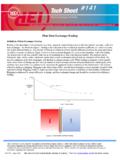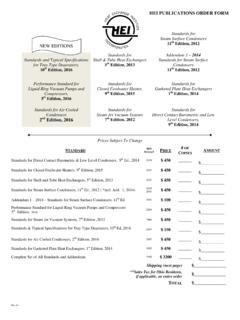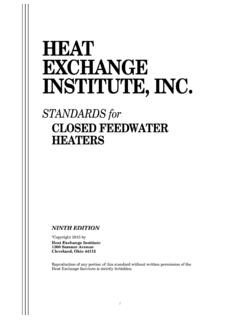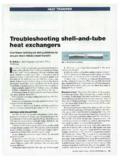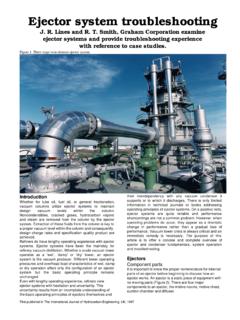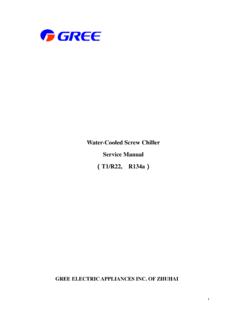Transcription of heat exchange inStitute, inc.
1 Iheat exchange inStitute, forShell & tube heat exchangerSFIFTH EdITIon Copyright October 2013 byheat exchange institute, inc1300 Sumner avenuecleveland, ohio 44115 Reproduction of any portion of this standard without written permission of the heat exchange Institute is strictly .. SCOPE AND PURPOSE .. DEFINITIONS .. heat EXCHANGER PERFORMANCE .. Exchanger Performance .. Fouling Resistance and Cleanliness Factor .. heat Exchanger Approach Temperature .. Tube Velocity .. Pressure Loss .. Nozzle Sizes .. Shell Inlet Area with Impingement Devices .. Shell Inlet or Outlet Area without Impingement Plate .. Bundle Entrance and Exit Areas .. Vent and Drain Connections .. heat Exchanger Operating Modes .. MATERIALS OF CONSTRUCTION.
2 General .. Gaskets and Packing .. Floating Head Split Backing Rings and Bolting .. Gaskets for Internal Floating Heads .. Halogenated Compounds .. Stainless Steel .. Nonmetallic Coatings and Liners .. MECHANICAL DESIGN STANDARDS .. Code Requirements .. Design Pressures .. Design Temperatures .. Hydrostatic Tests .. Corrosion Allowances .. Tubes .. Tubesheets .. Tube Bundles .. Shells and Shell Covers .. Channels, Bonnets, and Floating Heads .. Bolted Covers .. Packed Joints .. Nozzles and Supports .. Tube Vibration .. heat EXCHANGER PROTECTION .. Safety Requirements .. Relief Valves .. Cathodic Protection of Carbon Steel Channels .. Shop Cleaning.
3 Corrosion Protection .. Protection During Shipment and Storage .. Inservice Inspection .. External Surface Painting .. SITE INSTALLATION, INSPECTION, MAINTENANCE, AND CLEANING .. General .. Installation .. Installation and Operation Under Freezing Conditions .. Inspection .. Cleaning .. Initial Startup Precautions .. Startup and Shutdown of Fixed Tubesheet Exchangers .. Alterations and Repairs .. Spare Parts and Special Tools .. 25ivAPPENDICESA ppendix A heat Transfer Equations .. 26 Appendix B LMTD Correction Factors and Temperature Efficiencies .. 28 Appendix C Procedure for Calculating Allowable Nozzle External Forces and Moments in Cylindrical Vessels .. 42 Appendix D Areas of Circular Segments .. 47 Appendix E Bolting Data.
4 48 Appendix F heat Exchanger Specification Sheets .. 50 F-1 English Units .. 50 F-2 SI Units .. 51 F-3 MKH Units .. 52 Appendix G Standard Tolerances for Nozzles and Supports .. 53 G-1 English Units .. 53 G-2 SI Units .. 54 Appendix H Mechanical Characteristics of Steel Tubing .. 55 Appendix I Mechanical Characteristics of Tubing .. 56 Appendix J Modulus of Elasticity E of Materials for Given Temperatures .. 60 Appendix K Thermal Conductivity of Materials for Given Temperatures .. 61 Appendix L Metric Conversion Factors Nomenclature .. 62 Appendix M Typical Shell and Channel Arrangements .. 66 Appendix N Troubleshooting Guide .. 83 FIGURESF igure 1 Cleanliness Factor-Total Fouling Comparison .. 4 Figure 2 Loss Correction Factor (Kt) for Multiple Passes.
5 6 Figure 3 Shell Inlet Area with Impingement Plates .. 7 Figure 4 Shell Inlet Area with Impingement Rods .. 7 Figure 5 Shell Inlet or Outlet Area without Impingement Plate .. 7 Figure 6 Bundle Entrance and Exit Areas .. 8 Figure 7 Typical Baffles and Support Plates .. 14 Figure 8 Pass Partition Shape Factor .. 17 Figure 9 Packed Joint Construction Requirements .. 18 Figure 10 Nozzle Load Nomenclature .. 19 Figure 11 Methods of Support for the Unsupported Tube Span Under Consideration .. 20 Figure 12 Instability constants for Critical Velocity .. 21 Figure 13 Bolt Tightening Sequence .. 24 TABLEST able 1 Representative Fouling Resistances .. 5 Table 2 Maximum Tube Velocity .. 5 Table 3 Nozzle Size Criteria .. 6 Table 4 Materials of Construction .. 9 Table 5 Minimum Recommended Tube Wall Thicknesses.
6 11 Table 6 Minimum Recommended Tube Pitches .. 11 Table 7 Maximum Recommended Metal Temperature of Expanded Tube Joints in Carbon Steel Tubesheets .. 12 Table 8 Tube Hole Diameters and Tolerances for 13 Table 9 Tubesheet Drilling Tolerances and Maximum Recommended Tube Gages .. 13 Table 10 Cross Baffle and Support Plate Thicknesses .. 15 Table 11 Maximum Unsupported Tube Length .. 15 Table 12 Maximum Design Diametral Clearances Between Shell and Baffle .. 15 Table 13 Minimum Tie Rod Parameters .. 16 Table 14 Minimum Longitudinal Baffle Thicknesses .. 16 Table 15 Minimum Cylinder and Formed Head Thicknesses .. 16 Table 16 Minimum Pass Partition Thicknesses .. 17 Table 17 Packed Joint Parameters .. 18contentS (continued)
